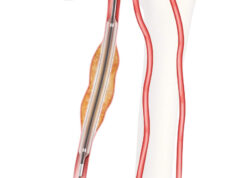Medical device developer R3 Vascular has reported the “successful initiation” of a first-in-human clinical study evaluating the technical and clinical performance of its Magnitude bioresorbable sirolimus-eluting scaffold (BRS) in patients with critical limb ischemia (CLI) due to occlusive below-the-knee (BTK) arterial disease.
The platform incorporates an innovative scaffold design and bioresorbable polymer technology resulting in biomechanical performance comparable to metallic stents, the Mountain View, California-based company said in a press release. The Magnitude BRS, specifically designed to balance mechanical strength and flexibility, uses a novel bioresorbable polymer that provides the structural support needed in this complex vascular territory. At a 98-micron strut thickness across all its usable range of diameters, the Magnitude BRS device is the thinnest BRS ever tested in this clinical setting, the release added.
“In this early clinical experience, we successfully tested the deliverability and mechanical performance of the Magnitude BRS,” said Marianne Brodman, MD, a cardiologist at Medical University of Graz, Austria, according to the release. “Post-procedural angiographic and duplex ultrasound data confirms the mechanical properties and ‘stent-like’ results of the Magnitude BRS device in presence of a high-disease burden. We are looking forward to expanding the patient population cohort and following the clinical results over time.”
Cardiologist Juan F. Granada, MD, a strategic advisor to R3 Vascular, added: “In BTK intervention, the prevention of vessel recoil following balloon dilatation is key to prevent negative remodeling and maintain vessel patency over time. BRS offer the best of both worlds by providing vessel support while it is needed and allowing the opportunity for future re-interventions, which is important in this type of patients. The successful validation of this technology may finally offer an effective and durable way to treat patients with this complex medical condition.”












